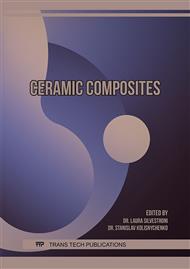[1]
Fahrenholtz, W. G., Wuchina, E. J., Lee, W. E. & Zhou, Y. ULTRA-HIGH TEMPERATURE CERAMICS : Materials for Extreme Environment Applications William G. Fahrenholtz Eric J. Wuchina William E. Lee Yanchun Zhou. (2014).
DOI: 10.1002/9781118700853
Google Scholar
[2]
Monteverde, F., Bellosi, A. & Scatteia, L. Processing and properties of ultra-high temperature ceramics for space applications. Mater. Sci. Eng. A 485, 415–421 (2008).
DOI: 10.1016/j.msea.2007.08.054
Google Scholar
[3]
Silvestroni, L., Meriggi, G. & Sciti, D. Oxidation behavior of ZrB2 composites doped with various transition metal silicides. Corros. Sci. 83, 281–291 (2014).
DOI: 10.1016/j.corsci.2014.02.026
Google Scholar
[4]
Jayaseelan, D. D. et al. Microstructural evolution of HfB2 based ceramics during oxidation at 1600-2000 degrees C. Adv. Appl. Ceram. 114, 277–295 (2015).
Google Scholar
[5]
Opeka, M. M., Talmy, I. G. & Zaykoski, J. A. Oxidation-based materials selection for 2000°C + hypersonic aerosurfaces: Theoretical considerations and historical experience. J. Mater. Sci. 39, 5887–5904 (2004).
DOI: 10.1023/b:jmsc.0000041686.21788.77
Google Scholar
[6]
Justin, J.-F. & Julian-Jankowiak, A. Ultra High Temperature Ceramics: Densification, Properties andThermal Stability. Aerosp. Lab J. 3, (2011).
Google Scholar
[7]
Guérineau, V. & Julian-Jankowiak, A. Oxidation mechanisms under water vapour conditions of ZrB2-SiC and HfB2-SiC based materials up to 2400°C. J. Eur. Ceram. Soc. 38, 421–432 (2018).
DOI: 10.1016/j.jeurceramsoc.2017.09.015
Google Scholar
[8]
Bouchez, M. et al. Combustor and Material Integration for high speed aircraft in the European research Program ATLLAS2. in (American Institute of Aeronautics and Astronautics, 2014).
Google Scholar
[9]
Kuhn, M. et al. Ceramic Strut Injection Technologies for High-Speed Flight. in 21st AIAA International Space Planes and Hypersonics Technologies Conference (American Institute of Aeronautics and Astronautics).
DOI: 10.2514/6.2017-2416
Google Scholar
[10]
Silvestroni, L., Fabbriche, D. D. & Sciti, D. Tyranno SA3 fiber-ZrB2 composites. Part I: Microstructure and densification. Mater. Des. 65, 1253–1263 (2015).
DOI: 10.1016/j.matdes.2014.08.068
Google Scholar
[11]
Paul, A. et al. UHTC-carbon fibre composites: Preparation, oxyacetylene torch testing and characterisation. J. Eur. Ceram. Soc. 33, 423–432 (2013).
DOI: 10.1016/j.jeurceramsoc.2012.08.018
Google Scholar
[12]
Li, L., Wang, Y., Cheng, L. & Zhang, L. Preparation and properties of 2D C/SiC–ZrB2–TaC composites. Ceram. Int. 37, 891–896 (2011).
DOI: 10.1016/j.ceramint.2010.10.033
Google Scholar
[13]
Hu, C., Pang, S., Tang, S., Wang, Y. & Cheng, H.-M. An integrated composite with a porous C-f/C-ZrB2-SiC core between two compact outer layers of C-f/C-ZrB2-SiC and C-f/C-SiC. J. Eur. Ceram. Soc. 35, 1113–1117 (2015).
DOI: 10.1016/j.jeurceramsoc.2014.10.005
Google Scholar
[14]
Zhang, S., Wang, S., Zhu, Y. & Chen, Z. Fabrication of ZrB2-ZrC-based composites by reactive melt infiltration at relative low temperature. Scr. Mater. 65, 139–142 (2011).
DOI: 10.1016/j.scriptamat.2011.03.033
Google Scholar
[15]
ASTM Standard E1876-09 - Standard Test Method for Dynamic Young's Modulus, Shear Modulus, and Poisson's Ratio by Impulse Excitation of Vibration.
DOI: 10.1520/e1876-15
Google Scholar
[16]
Anstis, G. R., Chantikul, P., Lawn, B. R. & Marshall, D. B. A Critical Evaluation of Indentation Techniques for Measuring Fracture Toughness: I. Direct Crack Measurements. J. Am. Ceram. Soc. 64, 534–553 (1981).
DOI: 10.1111/j.1151-2916.1981.tb10320.x
Google Scholar
[17]
Hu Chunfeng et al. In situ Reaction Synthesis and Mechanical Properties of TaC–TaSi2 Composites. Int. J. Appl. Ceram. Technol. 7, 697–703 (2009).
Google Scholar
[18]
Ben Ramdane, C. et al. Microstructure and mechanical behaviour of a NextelTM610/alumina weak matrix composite subjected to tensile and compressive loadings. J. Eur. Ceram. Soc. 37, 2919–2932 (2017).
DOI: 10.1016/j.jeurceramsoc.2017.02.042
Google Scholar



